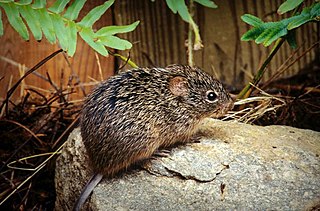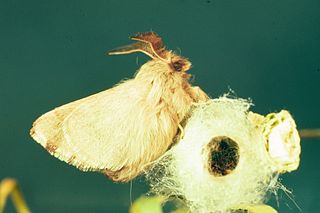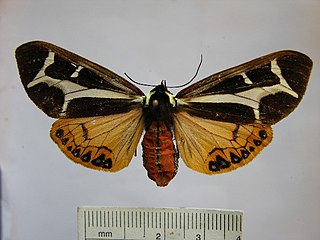
The Arctiinae are a large and diverse subfamily of moths, with around 11,000 species found all over the world, including 6,000 neotropical species. This group includes the groups commonly known as tiger moths, which usually have bright colours, footmen, which are usually much drabber, lichen moths, and wasp moths. Many species have "hairy" caterpillars that are popularly known as woolly bears or woolly worms. The scientific name of this subfamily refers to this hairiness. Some species within the Arctiinae have the word tussock in their common name due to people misidentifying them as members of the Lymantriinae based on the characteristics of the larvae.

A cotton rat is any member of the rodent genus Sigmodon. Cotton rats have small ears and dark coats, and are found in North and South America. Members of this genus are distributed in the Southwestern USA, Mexico, Central America and South American countries of: Venezuela, Ecuador, Colombia, Peru, Brazil, Guyana and Suriname. Many of the species are found in Mexico.

Asclepias asperula, commonly called green-flowered milkweed or spider antelope horns, is a species of milkweed native to the Southwestern United States and northern Mexico.

Cycnia is a genus of tiger moths in the family Erebidae. The genus was erected by Jacob Hübner in 1818.

Drasteria is a genus of moths in the family Erebidae.

Catocala desdemona, the Desdemona underwing, is a moth of the family Erebidae. The species was first described by Henry Edwards in 1882. It is found in Utah and Arizona, ranging south into New Mexico and Texas, and onwards through Mexico up to Honduras.
Drasteria hudsonica, the northern arches, is a moth of the family Erebidae. The species was first described by Augustus Radcliffe Grote and Coleman Townsend Robinson in 1865. It is found from Alaska and Yukon to California, east to New Mexico and Manitoba.

Drasteria sabulosa is a moth of the family Erebidae. It is found from British Columbia south into the United States where it found as far east as Wyoming, Utah, Colorado, New Mexico and as far south as Arizona.

Graphiphora augur, the double dart or soothsayer, is a moth of the family Noctuidae. The species was first described by Johan Christian Fabricius in 1775. It is found in all of Canada and most of the northern parts of the United States, south in the west to California and New Mexico. It is also found throughout Eurasia, from the British Isles and Scandinavia to Siberia and Japan.

Carmenta giliae is a moth of the family Sesiidae. It was described by Henry Edwards in 1881, and is found from western Alberta to north-western British Columbia, south to Arizona and New Mexico. The habitat consists of mid-to-high elevation montane meadows.

Malacosoma incurva, the southwestern tent caterpillar moth, is a species of moth of the family Lasiocampidae. It was first described by Henry Edwards in 1882. It is found in south-western North America, including Arizona, New Mexico, Nevada and Utah.

Cycnia oregonensis is a moth in the family Erebidae. It is found in most of North America, from coast to coast and from the border with Mexico north to central Saskatchewan and Nova Scotia.

Dysschema thetis, the northern giant flag moth, is a moth of the family Erebidae. The species was first described by Johann Christoph Friedrich Klug in 1836. It is found from the south-western United States to north-western Mexico.
Cycnia collaris is a moth of the family Erebidae. It was described by Asa Fitch in 1857. It is found from Arizona to Oklahoma and Florida.
Nelphe carolina, the Florida eucereon or Little Carol's wasp moth, is a moth of the subfamily Arctiinae. The species was first described by Henry Edwards in 1887. It is found in southern Texas, Florida, Mexico and on Cuba.

Pseudohemihyalea edwardsii, or Edwards' glassy-wing, is a moth in the family Erebidae. It was described by Alpheus Spring Packard in 1864. It is found in the United States from western Oregon and the Columbia Gorge in southern Washington south to California, in the south-west east to western New Mexico. The habitat consists of oak woodlands and mixed hardwood forests at low elevations.

Epipyrops exigua or Fulgoraecia exigua, the planthopper parasite moth, is a moth in the Epipyropidae family. It was described by Henry Edwards in 1882. It is found in North America, where it has been recorded from New Jersey and Pennsylvania to central Florida, west to Missouri, Texas, New Mexico, Arizona and California.
Stiriina is a subtribe of owlet moths in the family Noctuidae. There are at least 50 described species in Stiriina.
Stiriini is a tribe of owlet moths in the family Noctuidae. There are at least 120 described species in Stiriini.















